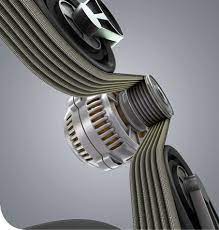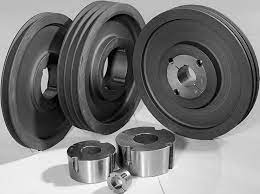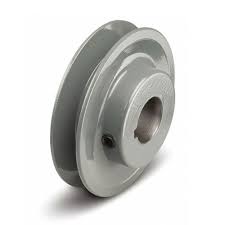Product Description
YL Belt Conveyor Drum Head Drive Pulley with Rubber Lagging
1.)Pipe: seamless steel : it was precisely cut by using the flame cutting machine.
2.)The sleeve & disc :it was cut by using the laser cutter machine precisely.
3.)Shaft: We chose 45# round steel & sleeve and process the whole shaft so that it ensures shaft concentricity and reduction for the eccentric shaft force. It make sure the pulley move more stable
4.)Bearing set & bearing: high-quality bearing which is hot charging and bearing block are equipped inner bearing enlargement device, so the bearing can be easily pushed to the bearing position and it avoids the bearing damage from the beating.
Testing for the pulley
We have the professional testing machine for the pulley. We need make the eliminating inner stress treatments when the pulley’s withstand forces exceed 80KN and we will make the static balance inspection when the belt speed exceeds 2.5m/s.
And we laso make the Drum dynamic balance test for the pulley to confirm the good quality before sent to the customer.
Packing:
After all the goods tested then make the packing, then the goods put into the warehouse to wait to send to the customer
Our projects:
Exhitbition and the customer visiting~
We also attend many kinds of related exhibitations to know more our products for the customer. Such as Canton fair, buma fair andother minging fairs.
Our company and products get the customer approve and many customer vist us and make the orders for us.
Company certificate &honor
We have the ISO 9001 certification The products have gained various patents. For example: Trademarks, patents,ects.
After sale service
We provide the customer best after sale services, and we solve the problems any time.
The company introduction:
HangZhou CHINAMFG conveying Machinery Co.,Ltd was founded in 2005.
It’s registered capital is 11.68million CNY and It is private joint-stock enterprise. Our main products are cnoveyor roller,idler,frame, pulley,belt and belt conveyor system for TD75 ,DTII,DTIIA,CEMA ects.
we has large lathes, numerical control, double pressing machine, double welding machine, double boring lathe, milling machine, sawing machine and so on. The products have gained various patents. We can produce more than 1 thousand rollers and 10 pulleys per day.
We have the professionalQC dept. to keep the good quality before the goods sent out. The products are sold to Middle East,Africa ,Australia,Europe,Southeast Asia,Russia and some other countries and regions. We will Strengthen the inner management and improve our products’ quality constantly.We will offer the best products for customers from the beginning to the end.
FAQ
1.Q: Your bearing type and brand usually use?
A:Large ball bearing type deep ball bearing withSRB, and according to customer’s requirements.
2.Q: How is your Payment Term?
A: T/T or L/C. Another payment term we can also discuss.
3.Q: Can you customize it?
A: We support customization according to your request.
4.Q: What’s the MOQ?
A: 3 piece.
5.Q: What’s the production capacity of your conveyor pulley?
20 pcs/day.
6.Q: What’s your roller’s lifetime?
Our pulley have a long lifetime with good performance and usually
make sure 30000 to 50000 hours under the normal site and operation.
Contact us:
Contact person: Sunny Li
| Material: | Carbon Steel |
|---|---|
| Surface Treatment: | Baking Paint |
| Installation: | Horizontal |
| Bearing: | Self-Aligning Ball Bearings |
| Pulley Lagging Type: | Heat/Thermal Vulcanized Rubber Casting, Rubber Lag |
| Surface: | Smooth, Diamond Grooved Lagging |
| Customization: |
Available
| Customized Request |
|---|

What are some real-world examples of drive belt pulley applications in various industries?
There are numerous real-world examples of drive belt pulley applications across various industries. Here’s a detailed explanation of some common examples:
1. Automotive Industry:
– Engine Systems: Drive belt pulleys are used in automotive engines to transmit power from the crankshaft to various engine accessories, such as the alternator, power steering pump, water pump, and air conditioning compressor. These pulleys ensure the proper functioning of these components and provide efficient power distribution in the engine system.
– Timing Systems: Timing pulleys and belts are employed in automotive engines to synchronize the rotation of the camshaft and crankshaft. This precise timing is crucial for the opening and closing of engine valves in coordination with the piston movement, ensuring optimal engine performance and fuel efficiency.
2. Industrial Machinery:
– Conveyor Systems: Drive belt pulleys are utilized in conveyor systems to transfer power from motors to conveyor belts. They enable the movement of materials, products, or components along the conveyor line, facilitating efficient material handling in industries such as manufacturing, logistics, and mining.
– Machine Tools: Drive belt pulleys are found in various machine tools, such as lathes, milling machines, and drills, to transmit power from the motor to the spindle or cutting tool. These pulleys allow for precise speed control and power transmission, ensuring accurate machining operations.
– Printing Presses: Timing pulleys and belts are used in printing presses to synchronize the movement of printing plates, ensuring precise registration and consistent print quality. The pulleys enable accurate timing and reliable power transmission for the complex mechanisms involved in the printing process.
3. HVAC Systems:
– Air Handling Units: Drive belt pulleys are employed in air handling units to drive fans and blowers that circulate air in heating, ventilation, and air conditioning (HVAC) systems. These pulleys enable efficient airflow and temperature control in commercial and residential buildings.
4. Agricultural Machinery:
– Tractors and Farm Equipment: Drive belt pulleys are used in tractors and various farm equipment to transfer power from the engine to components such as pumps, augers, conveyors, and cutting mechanisms. These pulleys enable tasks like plowing, planting, harvesting, and material handling in agricultural operations.
– Harvesting Machinery: Agricultural machinery like combines and forage harvesters employ drive belt pulleys to power the cutting mechanisms, threshing systems, and grain separation mechanisms. These pulleys ensure efficient harvesting and grain processing in the agricultural industry.
5. Fitness Equipment:
– Treadmills and Exercise Bikes: Drive belt pulleys are utilized in fitness equipment like treadmills and exercise bikes to transfer power from the motor to the running belt or pedals. These pulleys allow for adjustable speed control and smooth operation, providing users with an effective workout experience.
6. Construction Equipment:
– Concrete Mixers: Drive belt pulleys are used in concrete mixers to transmit power from the engine to the mixing drum. These pulleys enable efficient mixing of concrete during construction projects, ensuring uniformity and consistency in concrete production.
– Cranes and Hoists: Drive belt pulleys can be found in cranes and hoists to transmit power from the motor to the lifting mechanisms. These pulleys provide the necessary torque and speed control for lifting heavy loads in construction sites and industrial settings.
These examples highlight the wide range of applications of drive belt pulleys across industries, from automotive and industrial machinery to HVAC, agriculture, fitness equipment, and construction. Drive belt pulleys play a crucial role in power transmission, speed control, and reliable operation in various mechanical systems, contributing to the efficiency and functionality of these industries.

How do drive belt pulleys impact the performance of industrial machinery?
Drive belt pulleys play a significant role in the performance of industrial machinery. Here’s a detailed explanation of how drive belt pulleys impact the performance of industrial machinery:
1. Power Transmission:
Drive belt pulleys are responsible for transmitting power from the motor or engine to various components of industrial machinery. They provide the mechanical linkage between the power source and driven equipment, such as pumps, compressors, conveyors, and machines. The design and quality of the pulleys directly affect the efficiency and reliability of power transmission, impacting the overall performance of the machinery.
2. Speed Control:
Drive belt pulleys are instrumental in controlling the rotational speed of driven equipment. By using pulleys of different sizes or employing pulley systems with multiple belts, the speed ratio can be adjusted to meet specific operational requirements. This allows for precise control of machinery speed, which is crucial in applications that require varying operating speeds or synchronization with other processes.
3. Torque Transfer:
Drive belt pulleys facilitate the transfer of torque from the motor or engine to the driven equipment. The pulley design, including its diameter, groove size, and belt type, determines the torque-carrying capacity. Properly sized and designed pulleys ensure that the required torque is effectively transferred to the driven components, enabling the machinery to perform the necessary tasks with adequate force.
4. Belt Tension and Stability:
Drive belt pulleys help maintain proper belt tension, which is crucial for the stability and performance of industrial machinery. Tensioned belts ensure reliable power transmission by preventing slippage and maintaining sufficient contact between the pulleys and belts. The pulley design may include features such as tensioning mechanisms or adjustable pulley positions to facilitate proper belt tensioning and stability.
5. Load Distribution:
Drive belt pulleys aid in distributing the load across the machinery’s components. By properly sizing and aligning the pulleys, the load can be evenly distributed among the belts, pulleys, and driven equipment. This helps prevent excessive wear and stress on individual components, prolonging their lifespan and ensuring the overall performance and durability of the machinery.
6. Noise and Vibration Reduction:
Well-designed drive belt pulleys contribute to reducing noise and vibration levels in industrial machinery. Proper alignment, balance, and surface quality of the pulleys minimize vibration and noise generation during operation. This enhances the working environment, reduces operator fatigue, and improves overall equipment performance.
7. Maintenance and Serviceability:
The design of drive belt pulleys can impact the ease of maintenance and serviceability of industrial machinery. Pulleys that are accessible, have removable covers or guards, and allow for straightforward belt replacement or tension adjustment simplify maintenance procedures. This reduces downtime and ensures that the machinery remains operational and productive.
8. System Flexibility and Adaptability:
Drive belt pulleys offer flexibility and adaptability in industrial machinery. They allow for the integration of different power sources and driven equipment, enabling customization and expansion of the machinery’s capabilities. By changing pulley sizes or configurations, the machinery can be adapted to different operating conditions, power requirements, or production demands.
Overall, drive belt pulleys have a crucial impact on the performance of industrial machinery. They facilitate power transmission, speed control, torque transfer, belt tension, load distribution, noise reduction, maintenance, and system flexibility. Proper selection, design, and maintenance of drive belt pulleys are essential to optimize the performance, efficiency, and reliability of industrial machinery.

What are the advantages of using drive belt pulleys in automotive engines?
Drive belt pulleys offer several advantages when used in automotive engines. Here’s a detailed explanation of the advantages of using drive belt pulleys in automotive engines:
1. Power Distribution:
Drive belt pulleys enable efficient power distribution within the automotive engine. They transfer power from the engine’s crankshaft to various components such as the alternator, water pump, power steering pump, air conditioning compressor, and supercharger. This ensures that these components receive the necessary power to operate effectively, contributing to the overall performance of the vehicle.
2. Versatility:
Drive belt pulleys are versatile components that can accommodate multiple belts and drive various accessories simultaneously. They can be designed to have multiple grooves, allowing them to drive different systems and components within the automotive engine. This versatility enables the integration of various systems and accessories, enhancing the functionality and convenience of the vehicle.
3. Easy Maintenance:
Drive belt pulleys are relatively easy to maintain and replace. If a belt becomes worn or damaged, it can be easily removed and replaced without the need for extensive disassembly of the engine. This simplifies maintenance tasks and reduces downtime during repairs or belt replacements, ensuring that the vehicle can be quickly back on the road.
4. Efficiency and Performance:
Drive belt pulleys contribute to the overall efficiency and performance of automotive engines. By properly transferring power to driven components, they ensure the optimal operation of systems such as the alternator for electrical generation, the water pump for engine cooling, and the power steering pump for smooth steering. This results in improved fuel efficiency, reliable performance, and enhanced driving experience.
5. Cost-Effectiveness:
Using drive belt pulleys in automotive engines can be cost-effective. Compared to alternative power transmission systems, such as gear-driven systems, drive belt pulleys are often more affordable to manufacture and maintain. They also provide flexibility in accommodating different belt sizes and types, allowing for cost-effective customization based on specific vehicle requirements.
6. Noise and Vibration Damping:
Drive belt pulleys help dampen noise and vibrations generated by the engine and other components. The flexibility and elasticity of the belt, along with the design of the pulley, act as a cushion, reducing the transmission of vibrations and providing smoother operation. This contributes to a quieter and more comfortable driving experience.
7. Compact Design:
Drive belt pulleys have a compact design, which is advantageous in automotive engines where space is often limited. They can be integrated into the engine layout without requiring significant additional space or complex modifications. This compact design allows for efficient packaging of the engine components and contributes to overall vehicle weight reduction.
8. Customization and Compatibility:
Drive belt pulleys can be customized and designed to be compatible with specific automotive engine configurations. This ensures proper fitment and alignment with the engine’s components, reducing the risk of misalignment, slippage, or premature wear. Customization also allows for the adaptation of drive belt pulleys to different vehicle models and engine variations.
Overall, the use of drive belt pulleys in automotive engines provides advantages such as efficient power distribution, versatility, easy maintenance, improved efficiency and performance, cost-effectiveness, noise and vibration damping, compact design, and customization options. These advantages contribute to the reliable operation, optimal performance, and enhanced driving experience of vehicles equipped with drive belt pulley systems.


editor by CX
2023-11-16